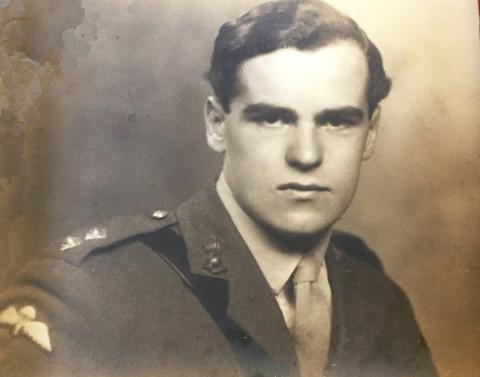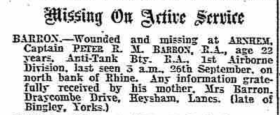Captain Peter Roderick MacGregor Barron, born on the 6 August 1922 in Beadle District, North Yorkshire. He was the youngest son of John and Helen Barron, of Morecambe.
He was granted an emergency commission, as a Second Lieutenant, in the Royal Regiment of Artillery, on the 17 January 1942.
He was posted from the 122nd Officer Cadet Training Unit, Larkhill, to the 204th Independent Anti-Tank Battery, RA on the 24 January 1942. [1] At this time the Battery was attached to the 219th Independent Infantry Brigade, responsible for guarding the South Coast of England.
He was promoted to War Substantive Lieutenant on the 1st October 1942, and on the 23rd October the Battery was redesignated the 2nd (Oban) Airlanding Anti-Tank Battery, RA, as it had been assigned to the 1st Airborne Division in August.
By now a Troop Commander, on the 12 April 1943 he boarded the MS Boissevain, at Gourock in Scotland, along with the rest of the Battery. They were bound for North Africa and landed at Oran on the 23rd April. Various training schemes were carried out in North Africa, usually in support of the 2nd Parachute Brigade, in preparation for a possible airborne operation that was due to take place in Sicily in July. However, this operation did not take place.
On the 8 September the Battery moved from M’Saken Camp in Tunisia to the port of Bizerta to embark on naval ships to take part in Operation ‘Slapstick’. They split into two parties: ‘F’ and ‘G’ Troops embarked on the U.S.S. Boise, with ‘E’ and ‘H’ Troops plus a skeleton Battery Headquarters boarded HMS Abdiel (Lieut. Barron was on this ship). These ships, part of a Royal Navy Cruiser Squadron, were bound for the Southern Italian port of Taranto. The USS Boise began to disembark her troops in the port at 23.00 hours on the 9th September, but at 00.30 hours, on the 10th September, HMS Abdiel struck a mine and sank in a few minutes. The Battery Commander, Major. JR Wilson was amongst those that were killed. [2]
In the reorganisation that took place Capt. AF Haynes (who had been the Second-in-Command), took over as Acting Battery Commander, and Lieut. Barron took over as the Acting Second-in-Command. [2]
The Battery initially supported the 4th Parachute Brigade, but then took over supporting the 2nd Parachute Brigade. They remained in Italy until the end of November 1943 (having handed over all their guns, vehicles and equipment to the newly created 300th Airlanding Anti-Tank battery, R.A.) and then sailed back to Bizerta in North Africa. A train journey from Bizerta to Blida took place between the 1st to the 6th December, and they remained there for nearly three weeks. They finally set sail from Algiers, on board the S.S. ‘Maloja’ on the 26th December and docked in Liverpool on the 4th January 1944. They were now to be billeted at Barleythorpe, near Oakham in Leicestershire.
In the reorganisation and expansion of the Battery that took place through the Summer of 1944, Capt. Barron was made Battery Captain ‘A’ (Administration), but still acted as the Battery Second-in-Command, and Capt. JR Elliott was posted in to take over as Battery Captain ‘O’ (Operations).
On Monday, 18 September 1944, Capt. Barron, along with five men, a jeep and trailer were loaded on board a Horsa glider at RAF Blakehill Farm, ready to take part in the 2nd Lift of Operation ‘Market-Garden’. Their glider was being piloted by S/Sgt. R. Browne and Sgt. S Auty of 5 Flight, ‘D’ Squadron, The Glider Pilot Regiment and was Chalk Number 773. The Dakota tug-aircraft was from 233 squadron, R.A.F. and being flown by Flt/Lieut. A. Cody, DFC, DFM. However, due to mechanical trouble with the glider the Dakota/Horsa combination was forced to land prematurely at Andrews Field aerodrome, near Chelmsford. The load was transferred to the Dakota which returned to Blakehill Farm later that same day (16.25 hours). Here they were allocated a reserve glider, and both glider pilots and their passengers would take off with the 3rd Lift.
Flying Officer Alan Hollingsworth was the Navigator aboard this aircraft: “Towing a heavily loaded glider in formation in a Dakota was always a slow tedious process and very exacting on both the pilot of the tug and the glider pilot, especially in the turbulence inevitably generated by a large formation. Just as we were approaching the coast of Essex we hit a very heavy patch of bumps and our glider had to let go. He glided down and landed at the US 8th Air Force base at Andrews Field near Chelmsford. We followed him down hoping that we would be able to take off again and re-join the formation. Unfortunately one of the tow-rope connectors was damaged in the landing process and after spending the afternoon watching the great ‘Balbo’ flying overhead, we loaded the contents of the Horsa into our aircraft and flew back to Blakehill Farm. By the time we had transferred the load to another Horsa it was too late to take off again that day and we had to wait until the morrow- Tuesday, 19 September”. [3]
The Unit War Diary states: ‘Air passage from Britain to Holland was fairly successful. During the passage to the Landing Zone four gliders fell short; one, containing 2 i/c Bty, came down in England.’
On the next day, Tuesday, 19 September, their ‘new’ glider, but with the same glider and tug crew took off again, Flying Officer Alan Hollingsworth: “The rest of the Squadron was stood down that day and we took off alone for Arnhem towing our new glider.
We were instructed to arrive over a place called s’Hertogenbosch at 1600 hours and join a formation of Stirlings to fly into the LZ at Arnhem with them in case there was ground fire. (Until this time operation MARKET GARDEN had been largely peaceful - none of the aircraft in our Group (No.46) had even been shot at.) We duly made our way to s’Hertogenbosch and we were overtaken by the promised Stirlings as we flew on into the Arnhem area.
As we approached the LZ there was very heavy light-flak and we were hit several times and so was the glider we were towing. The intercom through the tow rope went dead, the glider turned over on its back and dived into the ground (*). We followed him down and then hedgehopped back to Nijmegen. From there we flew on to our base at Blakehill Farm at normal height. When we taxied in from the runway, we were conscious of a noise like a shower bath and a strong smell of Avgas. The tower ordered us to switch off all electrics and leave the aircraft at once .... ‘Uncle Fox’s’ wing tanks had been perforated like a colander and until we landed, air pressure had kept the fuel from leaking out. And, quite unknowing, we had smoked all the way home .... We certainly were badly holed and it remained a crew joke for months afterwards that the aircraft batteries under the navigator’s seat saved my manhood”. [3]
(*) Note: Although hit by flak the glider landed okay, and the passengers were able to unload the jeep and trailer.
Capt. Barron was wounded on the 20 of September, but he and his Sergeant evaded capture on that day. He was Mentioned In Despatched on this date (announced in the London Gazette 20 September 1945). He also later refused treatment and chose to stay with his Colonel.
He was last seen at 3 am on the morning of the 26 September (during the withdrawal) on the North bank of the river, directing his men to safety. When he went forward to find out in what order the units were to be embarked, he subsequently disappeared without a trace. He has no known grave, but is commemorated on the Groesbeek Memorial to the missing (Panel 1).
NOTES:
[1] 204 Independent Anti-Tank battery, RA War Diary. January 1942.
[2] 2 (Oban) Air Landing Anti-Tank Battery, RA War Diary. September 1943.
[3] ‘Tugs and Gliders to Arnhem’. Arie-Jan van Hees.
By R. Hilton
Read More


Latest Comments
Add Comment
In order to add comments you must be registered with ParaData.
If you are currently a ParaData member please login.
If you are not currently a ParaData member but wish to get involved please register.